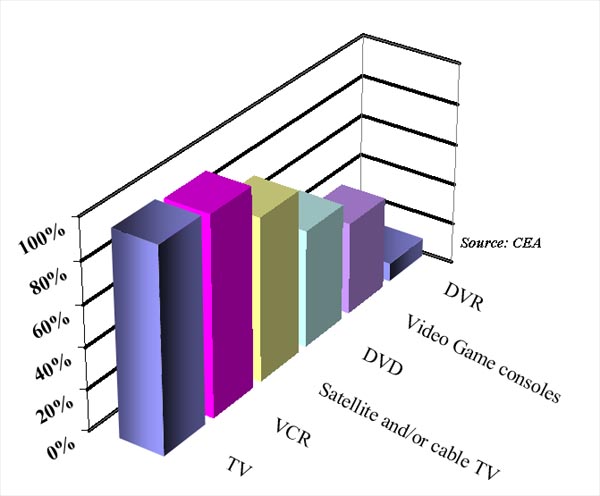There is a battle of epic proportions shaping up between Sony and Microsoft over the storage, delivery and management of digital media in and around the home. At stake for Sony – its continuing dominance of home entertainment electronics as it enters a new era. For Microsoft, it’s about winning or losing new territory for the Windows OS as the market for productivity PC’s matures.
Each company must build a long-term strategy around their greatest strengths and their opponent’s weaknesses – and we can see this strategy unfolding as the two announce their new home media products, Sony’s PSX and PS3, and the Windows XP Home Media Edition-based Media Center PC, and Xbox 360.
Of course, this battle will not be fought in a vacuum. There are numerous other technologies and standards that are jockeying for a piece of this new market. Video compression and wireless networking are two of the most important of these. Technology breakthroughs, the pace of standardization and commercialization, and licensing issues in both areas create opportunities and threats that will effect how both Microsoft and Sony unfold their game plan.
Developed by a Joint Video Team (JVT) of the ITU T and ISO/MPEG, the Advanced Video Codec, also known as H.264 and MPEG-4, Part 10, is a significant leap forward in video compression technology. The codec is at least twice as efficient as MPEG-2 for standard definition video and may be as much as four times as efficient for high definition. Unlike MPEG-4, Part 2 video, which was only about 20% more efficient than MPEG-2, there is a clear case for implementing AVC at some point to improve the performance of home media systems.
Although 802.11b and now 802.11g have become de facto winners for home networks, they are not designed to support the distribution of video in the home. Bandwidth and design constraints render them ill-suited to home media systems requiring multiple simultaneous streams of standard and/or high definition video to be transmitted throughout the home. A broad array of new technologies and standards are in development to address this problem. The speed and direction of the commercialization of these technologies will also play an important part in defining the home media system battlefield for the two giants.
Consumers want home entertainment, and demonstrated that with their pocketbooks. The consumption of home entertainment devices is huge and growing, and in the US as one example the average home has 2+ TVs, a game console if there are any kids, and most recently DVDs, as evidenced in the following chart.

Figure 1. Penetration of CE devices in US homes
One of the newest growth areas is the entertainment PC (EPC) which is made up of three categories or segments: Microsoft based OS non-Media Center PCs, Microsoft Media Center PCs, and non-Microsoft based OS EPCs (i.e., Linux and Apple.)
Sony and Microsoft are playing from their strengths in this battle for home media control. Because Sony knows consumer electronics better than anyone, a convergence box approach is their best bet. Their success with the PS2 has enabled them to rapidly develop many of the computing and control components that will be needed for such a platform, independent of Microsoft and Intel – hence the PSX, and probably some version of the PS3 slated for 2006 or beyond. Furthermore, local networking schemes like 1394 are much closer to making content owners comfortable with digital redistribution in the home by integrating the industry approved Digital Transmission License Authority (DTLA-5C) content protection scheme (DTCP). Microsoft, on the other hand, has little strength in consumer electronics and has been pretty badly bruised in its set top forays to date. Not surprisingly, Microsoft is adopting a strategy that might allow it to 1) avoid a head on confrontation with Sony in a battle for the set top, and 2) define the battlefield around storage, system management and networking rather than an integrated piece of home theater equipment. Their hurdle to overcome is the fact that wireless networking is currently unable to support its requirements.
Sony announced the inclusion of new video capabilities in their PSP. The PSP includes Sony’s proprietary UMD and, by using AVC will be capable of playing a high quality 120 minute movie from a single disk. Although the inclusion of AVC in the PSP specification represents a significant adoption of this new codec, there does not appear to be a strong correlation between its use in the PSP and its possible inclusion in PSX or PS3 – there is, as yet, no compelling application for an AVC decoder in PSX due to the fact that there has been no decision on an HD DVD format and AVC has not yet been adopted for satellite, cable or terrestrial digital video distribution. Unresolved technical and licensing issues are likely to force would-be adopters to continue to delay their decision on AVC for a year or more, while other options, like MPEG-2, H.264, and WM9 are clearly defined and ready to implement. However, as mentioned above, there is strong interest in AVC for VOD and with the right tie-ins, Sony’s AVC decoder could find its way into PSX for that purpose.














